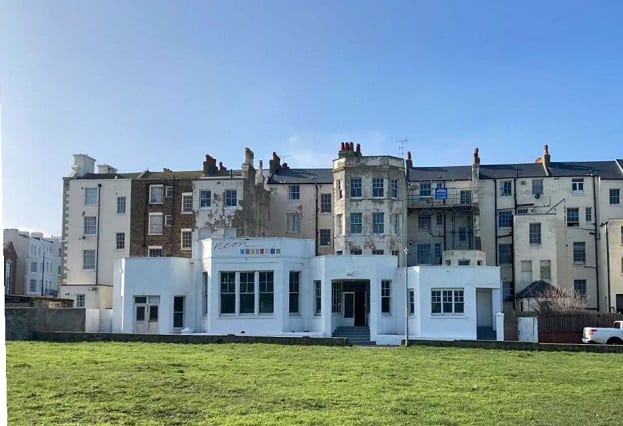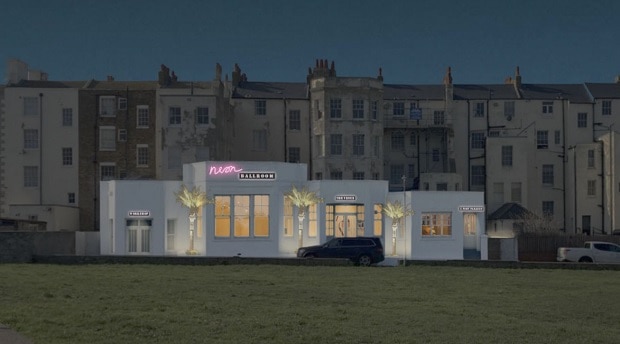
Proposals for the transformation of the former Caprice nightclub in Cliftonville into a neon fabrication workshop, and multi-generational live-work unit have now been approved by Thanet council.
Owner Kerry Ryan, who bought the site in 2019, aims to create a flexi-use site with an art gallery, art educational space, community space, wedding venue for hire, some residential accommodation on a temporary basis and use by artists in residence. There would also be 24 hour security guard presence during high value art exhibitions.
The combination of uses will create a new cultural space in Cliftonville, offering educational and career training opportunities.

Kerry, who comes from the Isle of Dogs in East London, creates neon installations for a host of clients and artists including Tracey Emin, Damien Hirst, Peter Saville and Cerith Wyn Evans.
The boss of Neon Specialists, which has bases in London and Miami, is creating the gallery and his studio in the original ballroom (later the nightclub, pool table and arcade areas) as well as the living space.
Kerry, who has five daughters, has been creating neons for more than 35 years and has worked for himself since he was 18.

He started out as an apprentice when he was 15. Talking to The Isle of Thanet News when he first bought the venue, Kerry said: “It was with Truman in Brick Lane. I was an apprentice in screen printing but they also had a neon department.
“I taught myself and went to the London School of Print in the Elephant and Castle. I set up on my own when I was 18 and then children came along so I had to work even harder!
“I’ve always rented studio space in London but now I have bought (Club Caprice) I don’t have to do that anymore.

“I used to come to Margate when I was a kid and always remember the doughnut stand at Bem Boms. From ten years ago to now there has been a transformation in Margate, it has become a New York city from a down town hood.
“I have friends here and am meeting more people here all the time.
“The main reason I bought it is for the view and the sea. I will have a studio looking straight over that and can just go out my door and go swimming in the sea.”
The first neon sign at Turner Contemporary was also made by Kerry for artist Sir Michael Craig-Martin.

In November 2019 Kerry exhibited a stunning neon light display and video installation at the former Artgame gallery in Margate’s Marine Drive as part of a six month residency.
Planning documents lodged with Thanet council earlier this year say: “The architectural vision is to conserve, make good and reveal the beautiful historic architecture, retaining the exposed brick masonry brick walls and floors. The ceilings, the ribs (mouldings on the beams), and the cornicing in the main building will be faithfully reinstated.

“Light touch minor alterations will complement the historic architectural design through a simple traditional material palette. The proposed development conserves the open character and historic plan form of the building, and does not subdivide the front space.”
Plans were submitted in March/April this year and then fresh proposals with some amendments for materials and layout were lodged in July. Approval was granted this month.
The neon workshop will be used to fabricate neon works and host education workshops and provide a training facility. The public will be able to come and watch neons being made.

The flexible space across the ground floor, lower ground floor and upper ground floor will be the live-work unit with three types of areas:
A large open space on ground floor level.
Shared by all areas, including a kitchen in the lower ground floor and associated stairs
Spaces for residential purposes where Kerry, daughters and grandchildren will stay over. This area will be closely interconnected with the more public parts of the flexible venue.

The most public areas in the middle two bays will have uninterrupted sea views over the old Lido. This will be used as an art gallery, education space, conferences, community events and/or wedding venue for hire. A disabled toilet will be installed.
A stud wall will be introduced between the two north bays, creating part of the multi-generational living area in the north bay and providing a wall for hanging art during exhibitions.

There are also plans for outdoor planting and sculptures.
Between 2-4 staff will be taken on at the neon workshop which will be open from 9am to 6pm each day. The live/work space is expected to have between four and six residents and have visitor capacity of around 220 per day with the same opening hours as the workshop.

In a council planning officer assessment, it says: “Overall the proposed works would help to retain and restore the character and appearance of the listed building with limited alterations to the historic fabric.
“Where additional features such as new staircases and windows to the rear of the property are to be installed these are to be constructed from metal providing a clear modern contrast to the older sections of the building.”
When finished the venue will be available for party hire and there are plans to get schools involved with the neon workshops.
The Grade II listed building falls within the Margate Conservation Area.

Paragon Court, a four storey Listed Georgian terrace, was built c.1830 and is located on Fort Paragon and the site forms part of this listing and building at basement level.
The historical maps show that there has been a building in the position of the club dating back to the 1891 and 1904 historical maps. It is believed the building was used as an entrance to Paragon Court and as an eating and entertainment area. Paragon Court consists of a number of converted flats.
The application site operated as the former nightclub, Club Caprice from the 1960s. Later nicknamed Jurassic Park by some regulars – on account of its ‘more mature’ clientele -the club ran right up until March 2016 by which point it was known as New Club Caprice.
The club site then remained empty until it was bought by Kerry in June 2019. Work had started that year but was hampered by the covid pandemic over the next two years.
Remembering Club Caprice
Memories of sticky carpets, ‘grab a granny’ jokes and a 6am closing time makes Margate’s Club Caprice a part of Thanet history.
The Cliff Terrace venue was the spot to grab a late night drink as far back as the 1960s. Later named Jurassic Park by some regulars – on account of its ‘more mature’ clientele -the club ran right up until March 2016 by which point it was known as New Club Caprice.
Signing off on facebook for the last time the club posted “End of error. Thanks for all the good times we had at the club, now to be turned into flats.”
Whether it really was the end of an error, or an era, depends on your point of view but the days of dancing to the Nolans are now over.
The Thanet Hidden History page unearthed these photos of the club’s sad end – plus we found a couple of snaps of party-goers enjoying themselves before the Club Caprice shut forever.

